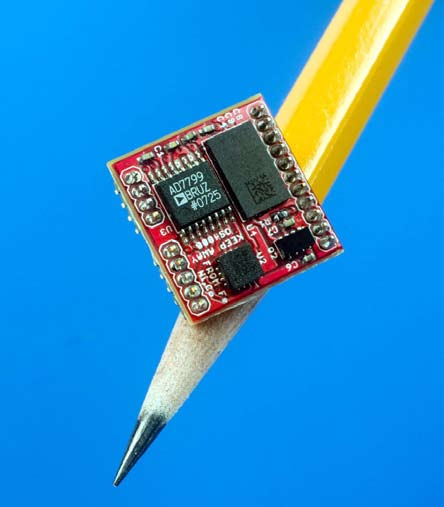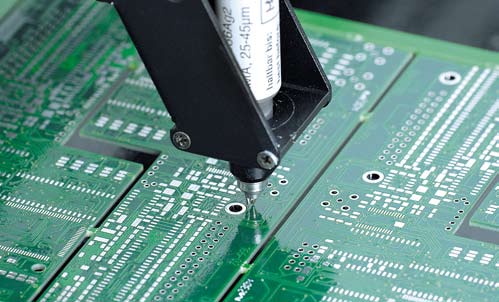
MAY 2009: While using a smart phone that performs all the scintillating digital magic earlier done by a computer, have you ever fancied what triggers the wonder? Or what helped these devices shrink their size while enduring power and performance?
Well, the wizard here is called surface-mount components—said to be the lifeline of surface-mount technology. Any electronic device—from LCD TVs to the latest small mobile phones—is today packed with these tiny devices. These devices help manufacturers pack more electronic components in a much smaller space while enabling more functionality.
SMT vs through-hole technology
The evolution of surface-mount technology dates back to the 1960s. However, this technology caught the fancy of users across the globe only in the 1980s. (For more details, see April 2008 issue of EFY.) Unlike its popular counterpart through-hole technology, components in SMT are directly mounted onto a printed circuit board (PCB). In through-hole, pins are inserted into drilled holes on a PCB.
SMT components have small metallic end caps which are directly soldered onto the PCB surface. This technology reduces the package size and improves functionality to a great extent on the same board-area. SMT places components on both sides of the PCB, which helps to reduce time in assembling the components. Placing components on both sides of the board also allows much higher circuit densities.
Surface-mount devices are very small and thin, compared to through-hole. Specifically speaking, these are one-quarter to one-tenth the size and weight, and one-half to one-quarter the cost of equivalent through-hole parts. This allows lower resistance and inductance at the connection, leading to better performance for high-frequency parts.
SMT components
Basically, SMT components come in two forms—passive and active. Passive SMT components include resistors and capacitors, while active components include diodes, transistors and integrated circuits.
In electronics industry, especially in the SMT segment, technologies are congregating to increase efficiency while keeping costs low. “Passive and active components are becoming so small today that these are barely visible to the human eye. Companies are integrating more functions into these tiny devices, helping fine-pitch these components,” says Prasad Chandrakant Gurjal, managing partner, Drive Technologies.
The prospect of reduced operational cost and time, as well as improved quality, is driving investment into research and development. Packaging style is improving so that components can be made as small as possible. The industry is reducing package dimensions of surface-mount device (SMD) resistors while maintaining fixed electrical performance characteristics of leaded devices. Size and weight are getting reduced because of lower voltages and higher speeds.
General trends
The growing demand for miniaturisation of consumer electronics has helped to reduce the size of passive SMT components. The 1210 and 1206 component sizes of the 1980s changed to 0402 and 0201 in the late 1990s.
“Today, the new and emerging size of 01005 is in demand, while 0603 and 0402 components have been in vogue in the recent years. These component sizes have been run in high-volume applications at very high yields for long time,” says S.K. Jain, CEO and MD, Sumitron Exports.
The new-generation wireless products require more functionality in less space, with lower weight, less power consumption and at higher frequencies. This is driving the use of smaller passives for system-in-package (SIP) modules. Lately, 0201 components have been used in such wireless applications as mobile phones and bluetooth devices. Capacitor and resistor manufacturers are now offering low-volume quantities of 01005 components and semiconductor companies, and electronics assembly manufacturers are gearing up to develop, and qualify, manufacturing processes, assemblies and components for their respective applications.
Design and packaging
With the growing complexity of components, interconnection density in the packaging is increasing. At the same time, there has been a large reduction in board space usage, and an increase in input/output (I/O) capacities. Companies are dreaming big here. The ultimate package is likely to perform all functions on a single integrated circuit (IC). Immense research is going on to improve packages such as ball-grid arrays (BGAs) and chip-scale packages (CSPs).
Size is still being reduced. Previously, bigger SMD packages like SOT89 were widely used. Now SOT 23 is commonly available.
The new series of consumer products are currently using CSP-size components. To attain the functionality and density of bare die assembly, new-generation devices have been introduced by the packaging industry. CSPs are 1.2 or 1.5 times larger than the perimeter or the area of the bare die. These devices assume the stress of miniaturisation while retaining the benefits of conventional IC packages. With growth in the CSP technology, the devices could be reduced to almost the size of the integrated circuit die itself.
The other package is in the form of a reduced-scale BGA, either in a partially or fully populated I/O condition.
“The increasing availability of the CSP significantly impacts the ability of product designers to design handheld products of a size and weight not previously possible,” says Jain. The new CSP allows a higher density of components to be placed into an increasingly smaller portion of an existing PCB, or the PCB may be reduced with an accompanying reduction in product size, weight and cost.
Today, manufacturers are extensively using chip-scale packages along with different passive components to design devices such as palm-sized camcorders. This method helps to significantly minimise the time taken in transmission of signals since the components are placed closely. Consequently, this system produces a slew of faster circuits.
The smaller size of these components, along with their reduced weight, higher density and increased performance, has widely influenced the technologies and techniques used to assemble PCBs.

Assembly and component placement
Assembly techniques are becoming more and more precise, with demand for both smaller size and fine-pitched lead spacing. The entire gamut of placement machines and printers now addresses stringent requirements for speed and accuracy, notes Gurjal.
In spite of advancements in surface-mount technology, majority of circuit boards still contain a variety of through-hole components. Their electrical performance and mechanical requirements are satisfying enough, so these could not be completely thrown out of the scene.
Through-hole components such as connectors, electrolytic capacitors, power diodes, relays and transformers are odd-form in nature. (Odd-form stands for components with such a height, weight or shape that these cannot be placed automatically with standard pick-and-place machines.) Usually, odd-form components have been placed on circuit boards using discrete insertion machines, dedicated hard-tooled automation or manual assembly. Discrete insertion machines are best suited for applications with several odd-form components. Dedicated hard-tooled automation has been used to meet the needs of high-volume, low-mix manufacturing. Mixed-technology circuit boards continue to challenge the odd-form assembly process.
As technology is advancing, SMT components may have short pins or leads of various styles, flat contacts, a matrix of solder balls or termination on the body of components.
Component placement entails two main functions: pick-up and placement. In manual placement, the component parts are picked up either by tweezers or by a vacuum pipette.
“For passive components tweezers are best suited, but for multi-leaded active devices a vacuum pipette is very helpful to deal with component rotation and recommended when working with manual placement of components,” says Jain.
Today, automatic placement machines are required for high-volume production as the manual method turns out to be very slow. It is also possible to achieve consistent quality levels with automatic placement equipment.
Technology advancing
The overall trend is happening on the size side. “Size is still being reduced. Previously, bigger SMD packages like SOT89 were widely used. Now SOT 23 is commonly available,” says Gulabchand Hariya, managing partner, SMD Electro Components.
Product manufacturers are listening to customer needs and want to implement changes for smaller, lighter and less expensive components. A second phase to this continued reduction in package size and weight is currently being experienced.
“As technology is advancing, SMT components are becoming slimmer and slimmer, with very small leads or no leads at all. These may have short pins or leads of various styles, flat contacts, a matrix of solder balls or termination on the body of components. And the manufacturing process of surface-mount devices is becoming much more sophisticated,” says Chetan S. Thakkar, managing director, DS Electronics.
The challenges
With opportunities opening more avenues for SMT component manufacturers, there are challenges that follow closely behind. Reworking is one such area. It does no good to rework one component, only to disturb several others during the process. There is need of high accuracy for rework systems.
SMT has to shift from its traditional high-speed dominance to higher accuracies. Diagnosing and preventing flip-chip and wafer-level packaging defects will be the key to cost-effective volume package production. With wire bonding and flip-chip bumping being the two major interconnect techniques, understanding the stages of SMT component production is of utmost importance. However, during the inspection and handling of such components, the reduced size of devices and high-density requirements create new challenges. Fortunately, the production process of semiconductor packages has today got a boost from automated optical inspection systems.
Shiny future
The future for SMT is bright, as one can see just how lights changed to DIP LEDs and how DIP LEDs changed to SMD LEDs, and also how telephone handsets changed to mobiles.
“So every electronic gadget will become small,” says Hariya. Time is ripe for SMT equipment manufacturers to implement the silicon cycle into their manufacturing lines to get a complete picture of package manufacture and its requirements. In the future, SMT assemblers will also witness more of wafer- and substrate-level packaging demands.
“Today, chip designers face a very demanding flock of users, with a vigorous appetite for speed, bandwidth, functionally and so on. Hence, areas such as repair and rework are envisaging a lucrative growth,” concludes Jain.
That indeed sounds prophetic and, of course, futuristic for SMT—the small wonder!







